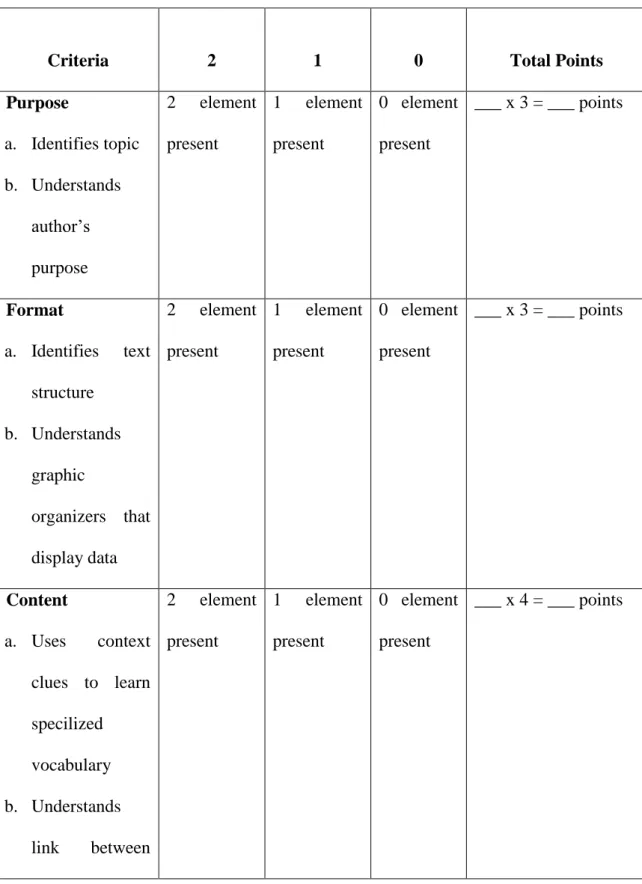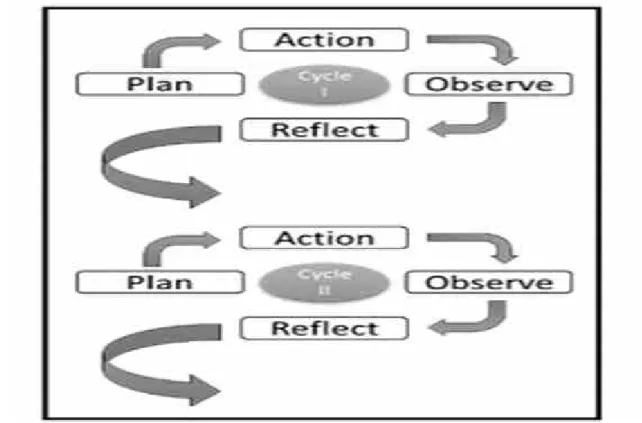The problem of SMP Negeri 2 Way Jepara eighth graders in reading is caused by various things. Therefore, the researcher checks a research proposal entitled “RESPONSE STRATEGY OF USING FACT QUESTIONS (FQR) TO IMPROVE READING COMPREHENSION OF EIGHT GRADES OF SMP NEGERI 2 WAY JEPARA IN ACADEMIC YEAR 2019.

Problem Identification
Problem Limitation
Problem Formulation
By implementing the FQR strategy, the teacher will find it easier to condition the students to be more focused in the process of learning to read. In addition, in the implementation of the strategy (FQR) it helps teachers to reduce saturation or habits in the process of learning to read.
Prior Research
The difference between this study and the second preliminary research lies in the differences in the research samples. The results of the second previous research prove that fact question answering (FQR) strategies are very effective in teaching speaking.
The Concept of Reading Comprehension 1. The Concept of Reading
The Concept of Reading Comprehension a. The Definition of Reading Comprehension
In addition, Brown says that when teaching reading, the teacher must know the specification of reading comprehension.17 That is, the teacher. Based on the above definition, reading comprehension is the human activity of reading a text by constructing meaning through interaction and engagement to gain information as they bravely read the text.
Measurement of Reading Comprehension
The Interactive Model argues that both top-down and bottom-up processes occur when a person reads a text. In multiple choice questions, it can ask about the details or general aspects of a text.
The Assessment of Reading Comprehension
To measure student comprehension, the teacher can use incomplete information transfer diagrams in the reading assessment. Based on the above definition, we can conclude that reading assessment is a process for collecting and processing information to determine students' ability to understand the read text.

The Concept of Fact Question Response (FQR)
The Nature of Fact Questions Response (FQR) Strategy
According to the definition above, the researcher concludes that Fact Question Response are strategies used to help students organize information as they read and search for answers to their questions.
Implementing of Facts Questions Response ( FQR) in Teaching Reading
After students have finished reading, have them enter their data into the Student Discovery Guide on the following page.
Advantages and Disadvantages of Fact Question Response (FQR) Strategy
Action Hypothesis
REASEARCH METHOD
Variable and Operational Definition of Variable
- Dependent Variable
- Independent Variable
Fact Questions Response (FQR) able to help students remember the content of the text more easily.
Subject and Object of Study
- Subject of Study
- Object of Study
Action research can be carried out by a researcher or a teacher as a curriculum leader. Action research in the classroom means that the teacher can know what the problem is in the classroom and find a solution to solve the problem.
Action Plan
- Cycle I
- Cycle II
In this step, the researcher observed the process of teaching learning by using Fact Questions Response (FQR). In this step, the researcher would compare the pre-test and post-test scores.

Data Collection Technique
The researcher doing the activities in this step such as: student's activities, student's understanding of the text, vocabulary and their summary. The researcher measures with a pre- and post-test form to see their ability before and after treatment. The researcher was given a pre-test at the first meeting before implementing the technique to find out the students' reading level and ability before the action research.
In the third phase, the observer observes the student's activity, their participations, classification during teaching and learning process, and the researcher's performance by using structure observation form and takes note of the overall activities. A field note is an observation tool used in CAR to provide a record of what is going on during an observation that includes description of places, people, objects, actions, activities, events, purposes, time and feeling.34 In this research, the researcher uses a field note, drawing the student's activity during the learning process in narrative form.
Data Collection Instrument
Field note is observation tool used in CAR to provide a record of what is going on during an observation which includes description of places, people, objects, actions, activities, events, purposes, time and feeling.34. In this research, the researcher uses the field note record of the student's activity during the learning process in narrative form. a. To identify the students' reading comprehension of the eighth grade of SMP N 2Way Jepara, the researcher uses appropriate reading test.
The test measures the ability of the students on the subject of reading. The test consists of pre-test and post-test, some of this research will be in the form of multiple choice test that asks the students to choose a correct answer.
Data Analysis Technique
If in cycle II 75% of students were successful, the cycle can be interrupted until cycle II. The analysis of the learning result was obtained from the average score of the pre-test and the post-test in cycle I and cycle II. Tabulation of the test result and finding the mean of the test before and after the test.
Indicator of Success
Result of the Research
- Description of Research Location
- Description of the Research
- Description of The Research
- Cycle I a) Planning
Therefore, the researcher used the Fact Question Response (FQR) Strategy to improve students' reading comprehension. The researcher gave the reading text to the students and then the researcher asked some students to read the text. Then the researcher explained the meaning of the text and then the researcher asked the students questions about the text they read.
If the students would answer the question, the researcher gave the correct answer to the students. This meeting began by praying and greeting, checking the attendance list and asking the students how they were doing.
Post-test I
The graph showed that the learning activity of the students did not reach the 70% mark. It could be concluded from the result observation in the learning process in cycle I that the Minimum Passing Grade of the research has not yet been achieved in the learning process. At the end of this cycle, the researcher analyzed and calculated all the processes, such as the students' pre-test grade and the students' post-test I grade result.
The Students' Learning Activity
Improving Explanation
Comparison of the percentage of completion of students' grades based on the pre-test and post-test I. In the table and graph above, in the pre-test it can be seen that out of a total of 30 students, it can be concluded that 4 students or 13% of the total students managed to reach the minimum passing grade which is ≥ 75. Then the students who did not reach the minimum passing grade were 26 students or 87% of the total students.
In post-test I it could be concluded that 13 students or 43% of the total students completed the minimum pass grade. Then those who could not achieve the minimum pass grade were 17 students or 57% of the total students.
Post-test II
Based on the above result, it could be concluded that 24 students (80%) were successful and 6 other students (20%) were not successful. Based on the result of the observation sheet in cycle II, the researcher indicated that the learning process in cycle II was successful. The learning activity of the students had a high percentage with the students paying attention to the teacher's explanations 83%.
Based on the result above, the researcher indicated that learning process in cycle II was success because the students' learning activity percentage achieved which is 80%. From the result of the learning process in cycle II, the researcher analyzed that the vocabulary mastery was generally improved through the use of Fact Question Response (FQR) Strategy.
Learning Activities
At the end of this cycle, the researcher and the collaborator analyzed and calculated all processes, such as the student's second grade after test II and the observation of the student's learning activities. The comparison between students after test I grade and post test II grade can be compared in the following table.
Improving Explanation
Discussion
Using the Fact Question Response (FQR) strategy, students seriously learn to read a text by finding a fact that is in the text and can respond using their own thoughts. Based on the explanation of cycle I and cycle II, it can be shown that the use of question and fact response strategy could improve students' reading comprehension. It was researched that there was an improvement in the total score of the students and the total score of the students who achieved the lowest scores from pre-test, post-test I to post-test II. So, it has been proven that the Fact Question Answer (FQR) strategy is one of the interesting strategies in learning English reading, especially for the eighth grade students of SMP Negeri 2 Way Jepara.
Although in cycle 1, the students' skill is still poor according to their score because almost most of the students could not reach the target of the minimum knowledge criterion, in cycle 2, most of the students were able to reach the target of the minimum knowledge criterion. Teaching reading comprehension using the Fact Question Response (FQR) strategy could encourage students to become interested in the learning process, and students would feel that they enjoy Fact Question Response (FQR), and students would not just sit and listen, but you should also read. the text and students need to understand the meaning of the text they are reading.
Suggestion
It is advisable for the principal to support the English teacher in using Fact Question Response Strategy in the learning process as Fact Question Response (FQR) Strategy is very helpful in the process of learning English. Using Fact Question Response (FQR) Strategy to Improve Student Reading Performance, in Journal of English Language Teaching, Vol. Ellen Fogelberg, Carole Skalinder, Patti Satz, Barbara Hiller, Lisa Bernstein, and Sandra Vitantonio, Integrating Literacy and Math Strategies for K-6 Teachers, New York: The Guilford Press, 2008.
IsmiRina, The Effect of Using Facts, Questions, Answers (FQR) Strategy towards the Speaking Comprehension of Freshmen in SMAN 12, PekanBaru: Department of English Education, Sultan Syarif Kasim Riau State Islamic University PekanBaru, 2014. Groeber, Design and Using Reading and Language Arts, K-6 Second Edition California: Corwin Press, 2007. Reading Strategy in the Seventh Grade Private Islamic Middle School Jami' Al KautsarTapungHilir,"(Sumatra Utara: Department of English Education, Faculty of Tarbiyah and State of Teacher Training Islamic University of Sumatera Utara, 2017.
RetnaHandayani, Teaching Reading Comprehension In News Item Text By Use Fact Questions Response Strategy, StateIslamic University of Raden Fatah, Palembang, South Sumatra, Vol 4 No.